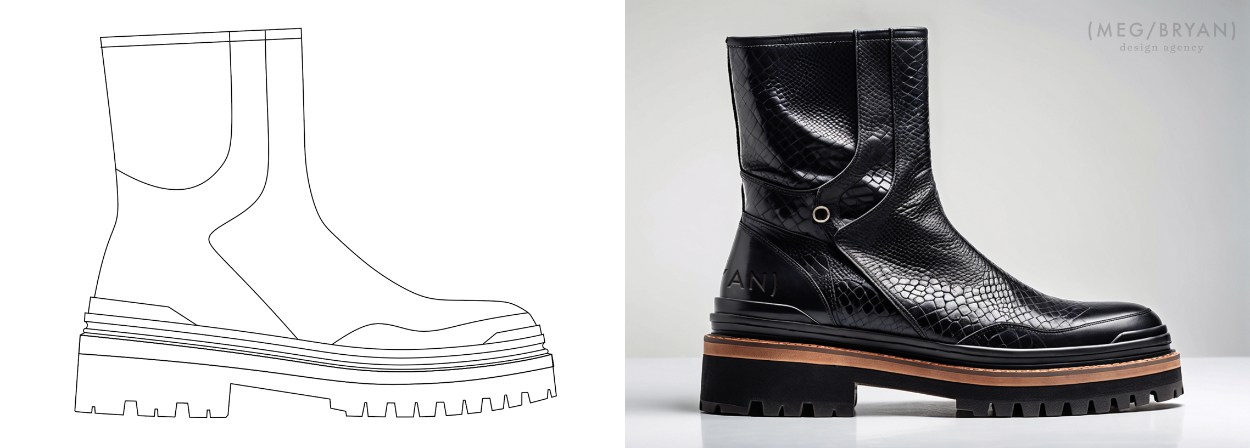Released in The Interline’sAI Report 2024, this executive interview with NewArc.ai is one of a fourteen-part series that sees The Interline quiz executives from companieswho have either introduced new AI solutions or added meaningful new AI capabilities into their existing platforms.
For more on artificial intelligence in fashion,download the full AI Report 2023 completely free of charge and ungated.
What’s your working definition of AI? Does it differ from the public understanding, which is currently dominated by large language models and generative text-to-image models? And how does that definition manifest itself in your solution(s)?
My definition of AI is centered on its role as a transformative tool that elevates ideas over traditional hard skills such as manual painting, writing or using complex graphic editors. AI allows individuals to express and communicate their creative visions without spending hundreds of hours mastering these skills. This democratization of creative expression makes AI a great equalizer, giving more people the opportunity to bring their ideas to life, regardless of their background or technical skills.
But while AI opens up new possibilities, success in this new era still requires a deep understanding of your field. Think of it as becoming an “art director” in whatever field you’re working in, whether it’s fashion design, footwear design, product design, or any other creative industry. Having access to AI tools like the ones we’re developing at NewArc.ai doesn’t replace the need for a solid grounding in the principles of good design and aesthetics. You can have the best tools, but without the right knowledge and vision, the result may not reach its potential.

At NewArc.ai, we empower designers, from freelancers to established brands, with an AI-powered tool that turns sketches into high-quality, photorealistic images in seconds. This not only streamlines the design process by eliminating time-consuming manual work, but also increases creative freedom by allowing designers to quickly explore and test more ideas. In addition, our technology reduces the reliance on physical samples, promoting sustainability and improving communication with clients and teams. By focusing on the creative aspect of design, NewArc.ai helps designers maximize their potential.
Over the last decade, a lot has been asked of designers when it comes to learning specialised skills and new tools in order to bring their ideas to life – and communicate them to other stakeholders – more quickly. How do you think about the way that progress in design has become something of a productivity and technology treadmill? And can AI provide an alternative pathway to shortening the distance between idea and visualisation?
In recent years, the fashion and footwear industries have become increasingly more fast-paced. Designers are expected to produce more designs in less time, a demand that can be quite exhausting and potentially stifling for creative professionals. This push for productivity often results in sacrificing the creative, artistic part of the designer’s job, leading to designer burnout – and lack of fresh ideas, which can be very harmful to the world of fashion and footwear.
Historically, tools like Procreate, Illustrator, Photoshop, CLO, and Browzwear have been instrumental in helping designers become more efficient. However, mastering these tools involves a significant learning curve and the visualization process can still consume many hours. Now, in the AI era, we’re seeing a shift. A wave of new startups, alongside established software developers integrating AI features, are aiming to reduce the burden of tedious tasks, allowing designers to focus more on the creative aspects of product creation.
At NewArc.ai, our approach focuses on two critical stages of product creation: ideation and presentation.
Ideation: Traditionally, designers generate numerous sketches but only a few are developed into more detailed illustrations due to the time-intensive nature of the process. With NewArc.ai, every sketch can be instantly transformed into a photorealistic image, enabling designers to explore and evaluate a broader range of ideas more efficiently.
Presentation: The traditional approach often requires hours to create compelling images to present ideas to stakeholders. With NewArc.ai, this process can be dramatically shortened. Designers can quickly generate multiple images from a single sketch, select the one that best aligns with their vision, and make necessary adjustments like adding logos or tweaking colors, all within an hour.

Early in the AI era, many designers were concerned about whether AI was a threat or an ally. It’s now clear that AI is a powerful tool that streamlines workflows, enhances creativity, enables more extensive idea testing, reduces tedious labor, and improves communication with clients and teams. AI is not just about keeping pace with technological advancements; it’s about giving designers the space and tools to truly innovate.
Generative AI is a fascinating example of a new class of technologies creating a level playing field: for the same small monthly fee, anyone at home can use the same large, cloud-hosted models that workers at the world’s biggest enterprises do. This universality is part of what drove ChatGPT adoption so quickly. I’s also a cornerstone of the philosophy behind NewArc.ai, where the real beneficiary of AI adoption is the individual designer – whether they work alone or as part of a team.
The democratization of technology through SaaS models has shifted the landscape for businesses and individuals. This shift started with making enterprise-grade software accessible to solopreneurs many years ago. But unlike traditional software, AI’s potential to enhance lives and careers is enormous, which is why it’s crucial that these capabilities are available to everyone, not just a select few.
At NewArc.ai, we embody this philosophy by making our AI tools accessible to a wide range of users, from hobbyists to professional designers working for major brands worldwide. We believe the real winners are the entire apparel and footwear industries, as well as the end consumers.
In practice, this democratization is likely to play out in several powerful ways over the next few years:
- Enhanced Creativity and Innovation: With tools like NewArc.ai, more individuals can bring their unique ideas to life without the barrier of needing traditional, often expensive, design training. This will lead to a surge in creativity and a diversity of concepts entering the market.
- Increased Market Competition: As more designers gain the ability to produce high-quality designs quickly, competition will increase. This, in turn, will drive improvements in both product quality and cost-efficiency, benefiting consumers.
- Global Market Access: Designers from any part of the world will be able to create products that appeal to global audiences, fostering cultural exchange and economic growth through a more integrated market.
- Sustainability: By reducing the need for physical samples, AI tools will decrease waste and carbon emissions, contributing to a more sustainable fashion industry.
- Economic Resilience: Broad access to AI prevents a concentration of power and resources within a few large corporations, enhancing the overall economic resilience.
In summary, as AI tools become more universally accessible, they will empower more individuals and businesses, leading to a more diverse, sustainable, and competitive market. It’s a historical transformation that NewArc.ai is proud to be part of.

Fashion is one of your leading categories, but NewArc.ai also caters to other sectors like automotive and industrial design. What parallels are you seeing in AI adoption across those different industries, and what sector-agnostic best practices are emerging? And how do you approach creating AI applications that have the deep domain capabilities necessary for fashion?
The adoption of AI is now a key strategy in virtually every industry, as companies explore how it can add value to their operations.
At NewArc.ai, we know that design processes in fashion, footwear, automotive or industrial design often start with a sketch. This common starting point allows our service to be useful to designers in these sectors.
Our platform focuses on quickly transforming initial sketches into photorealistic images, which is particularly valuable when designers need to communicate their ideas to stakeholders. The ability to visualize a concept as a life-like image can significantly improve communication and speed up decision-making. This is becoming a standard expectation across industries – soon the presentation of a hand-drawn sketch may surprise stakeholders used to more refined photo-like visuals.
Despite these similarities, the need for deep domain expertise remains critical. At NewArc.ai, while we offer solutions that meet the basic needs of various design-focused industries, we invest considerable effort in understanding and addressing the specific needs of apparel and footwear designers. We engage directly with our users, gathering extensive feedback through emails and phone calls to guide our product development. This user-centric approach ensures that our AI not only supports general design tasks, but also excels at the nuanced demands of the fashion industry.
What does it mean, from your perspective, to prepare the next generation of designers for a very different world to the one that traditional education might lead them to expect? We struggled to get much in the way of concrete commitments from universities and institutions in the research phase of this report, so tell us how NewArc.ai is partnering with education and working to support new talent through grassroots programmes.
Preparing the next generation of designers for a rapidly evolving industry means equipping them with cutting-edge tools and technologies that reflect current professional standards. Traditional educational curricula often lag behind the technological advancements, leading students to seek out modern solutions independently.
At NewArc.ai, we recognized this gap early on. Interestingly, it was initially students who introduced our AI-driven design tool to their educators, reversing the typical learning dynamic. This led us to launch a program in the spring of 2024 to provide NewArc.ai for free to educational institutions, including universities, schools, and design courses.

We’ve committed to supporting institutions such as SCAD, FIT, Macromedia, Iowa State University, and other early adopters who understand the necessity of incorporating AI into their programs.
These partnerships are not just about providing access to our tools but also about actively collaborating with educators to develop curricula that include AI. By doing so, we help bridge the gap between academic preparation and industry expectations, ensuring that graduates are not only competitive but also pioneers in their fields.
The pace at which universities adopt these technologies varies, but the direction is clear: integrating AI into design education is inevitable.
What do you see as the near-term future of AI – both within your solution(s) and in general? Do you believe it will be a transformative class of technologies the way people expect?
Recent advances in AI are not just incremental; they represent a fundamental shift similar to the invention of electricity. This is a bold comparison, but I believe that in ten years’ time we will look back on this time as a turning point in the evolution of technology.
The integration of AI into different services is accelerating, and the technology itself is becoming increasingly sophisticated. In the near term, we can expect businesses to continue to embed AI into their frameworks, leading to a proliferation of new applications that were previously unimaginable. The pace at which the distant future is becoming the present is faster than ever, and the next few years are critical as AI becomes an integral part of our daily professional and personal lives.
At NewArc.ai, our focus remains on refining our AI-driven tools to ensure they are the leading solutions in the market for fashion and footwear designers. We aim not only to keep pace with developments in AI, but to set the standard for them, ensuring that our tools are as innovative and effective as the designers who use them.